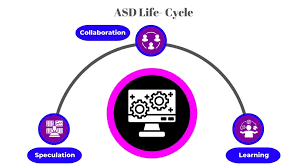Adaptive software development (ASD) is an agile software development methodology that emerged in the 1990s as an alternative to traditional, plan-driven approaches like waterfall development. ASD emphasizes adapting quickly and efficiently to changes in requirements and the project environment.
In this blog post, we’ll cover everything you need to know about adaptive software development, including:
- What is adaptive software development?
- Key principles of ASD
- Phases in the ASD lifecycle
- When is ASD a good choice?
- Advantages and disadvantages of ASD
- How ASD compares to other agile methodologies like Scrum
Let’s get started!

What is Adaptive Software Development?
Adaptive software development is an iterative and incremental agile methodology centered around adaptability and collaboration to handle ambiguous requirements and rapid change.
The core idea behind ASD is that software projects exist in a complex, uncertain environment. Requirements are unclear and likely to evolve over time as stakeholders better understand their needs. The development team must be empowered to adapt quickly to ever-changing conditions for the project to succeed.
In ASD, the focus is on incremental delivery of working software, not comprehensive documentation. Requirements are developed collaboratively between customers and cross-functional teams. Plans are revised throughout the project lifecycle based on feedback and lessons learned from delivering working functionality in short cycles.
The goal is to deliver higher quality software faster by embracing, rather than resisting, the dynamic nature of building complex systems. ASD values responding to change over following a rigid plan.
Key Principles of Adaptive Software Development
ASD is built on three foundational pillars:
Collaboration Between Cross-Functional Teams
In ASD, development teams should include representatives from across the organization – not just developers but also customers, project managers, QA testers, and more.
Bringing diverse perspectives together in collaborative teams allows for better communication, shared learning, and rapid adaptation to changing needs.
Adaptive Cycle Planning
The ASD lifecycle is organized into a series of adaptive cycles rather than pre-planned linear phases. Each cycle includes speculation, collaboration, and learning phases where teams hypothesize requirements, build/test them, and reflect on what worked or didn’t work.
Plans are regularly revisited and updated based on feedback from delivering working software. The focus is responding to change, not blindly following an inflexible plan.
Rapid Value Delivery
ASD emphasizes building and delivering functionality in short iterations. Each adaptive cycle culminates in a working product increment that delivers tangible value to stakeholders.
Frequent delivery of valuable software helps validate requirements and get rapid feedback to incorporate into the next cycle.
Phases in the Adaptive Software Development Lifecycle
The ASD lifecycle has three repeating phases:
Speculate
The speculate phase is about envisioning the objectives and requirements for the next development cycle. Customers and developers collaborate to identify features that will deliver the most value given what has been learned so far.
There is an emphasis on speculation and brainstorming, not detailed requirements documentation. The speculate phase sets the goals for the next increment but remains open to adapting as needed.
Collaborate
In the collaborate phase, cross-functional teams work together to design, build, and test the functionality identified during speculation.
Requirements errors and misunderstandings surface through collaboration and transparency between customers, developers, testers, and other stakeholders. Rapid feedback loops mean defects can be fixed before major damage is done.
Learn
After delivering the software increment, the team reflects on what worked well, what issues arose, and how to improve for the next cycle. Feedback on the current increment is solicited from both customers/end-users and team members.
Lessons learned during development and real-world use of the latest increment are fed back into the process to refine requirements and plans for future cycles.
The learning phase completes the adaptive cycle, which then repeats starting back at the speculate phase.
When is Adaptive Software Development a Good Choice?
Adaptive software development is a great fit for projects with:
- Unclear or rapidly changing requirements
- Significant complexity and uncertainty
- A dynamic business environment
- Multiple stakeholders with competing priorities
- The need to develop innovations or new capabilities
The iterative approach allows development teams to explore ambiguous or cutting-edge requirements without overcommitting upfront. ASD provides the flexibility needed to handle volatility in priorities or objectives even late in development.
If requirements are crystal clear and unlikely to undergo changes, a predictive plan-driven methodology like waterfall may work fine. But for most business software projects today, ASD offers key advantages.
Advantages of Adaptive Software Development
Here are some of the biggest benefits of using an adaptive approach:
Manages Changing Requirements
Frequent repetition of development cycles based on learning and feedback allows ASD teams to gracefully handle changing requirements. Needs can be reprioritized or revisited in each new speculate phase.
Reduces Risk
The iterative approach and emphasis on rapid feedback lets teams identify potential issues early when they are easiest to fix. Adaptive cycles limit risk by dividing the project into smaller, lower-risk increments.
Improves Quality
Quality is improved through an ongoing collaborative focus between customers, developers, testers and other stakeholders. Incremental delivery exposes defects soon after they are introduced when they can be readily fixed.
Empowers Teams
ASD provides flexibility for development teams to use their expertise to determine the best technical solutions vs forcing rigid, predefined answers. Teams feel empowered to adapt based on lessons learned.
Delivers Value Early
Stakeholders realize tangible benefits through regular delivery of working software increments that provide the highest business value.
Promotes Innovation
The ability to rapidly explore and refine ambiguous requirements promotes creativity and innovation – especially for building unprecedented systems. Teams can speculate on needed capabilities and iteratively turn those ideas into reality.
Potential Disadvantages of Adaptive Software Development
While ASD provides significant advantages, there are also some potential downsides to consider:
- Requires customer involvement: ASD depends on active customer engagement to be successful. Lack of customer input cripples the methodology.
- Challenging team coordination: Juggling multiple adaptive cycles with different teams demands strong program management and communication skills.
- Scope creep risks: The flexibility to add new requirements or user stories late in development can sometimes lead to uncontrolled growth in scope.
- Less predictable schedules: While adaptive cycles provide general cadence, the indirect nature of ASD makes detailed long-term plans and timelines more fluid.
- Dependency challenges: Managing dependencies between features developed by different teams in separate cycles requires thoughtful coordination.
- Not ideal for routine work: ASD strengths shine for complex domain problems but may be overkill for simple projects with clear static requirements.
How Adaptive Software Development Compares to Scrum
Scrum is the most widely adopted agile methodology. Like ASD, it delivers software iteratively and incrementally based on feedback. But there are also key differences:
- Roles – Scrum defines specific roles like Product Owner and Scrum Master. ASD focuses more on collaboration between cross-functional teams.
- Cycle length – Scrum sprints are typically 1-4 weeks long. ASD cycles vary based on project needs and can be longer.
- Requirements – Scrum user stories are defined at sprint start and not changed mid-sprint. ASD builds in more flexibility to revisit requirements each cycle.
- Planning – Scrum has more regimented sprint planning with daily standups and backlog grooming. ASD has fewer prescribed ceremonies.
- Team organization – Scrum teams are typically structured as a single, stable development team. ASD encourages composing teams differently each cycle based on current needs.
Both ASD and Scrum are valid modern agile methodologies. Scrum offers more prescriptive structure while ASD emphasizes flexibility. Teams can even blend practices from both frameworks as appropriate for their specific project and environment.
Conclusion
Adaptive software development provides an iterative, incremental approach optimized for projects with ambiguous or volatile requirements.
Key tenets of ASD include:
- Cross-functional collaboration
- Speculate, build, learn cycles
- Adapting plans based on feedback
- Rapid delivery of high-value increments
By embracing change rather than resisting it, adaptive teams can deliver innovative high-quality solutions even under unpredictable conditions. The emphasis on early learning and incrementally refining requirements based on working software accelerates value delivery while controlling risk.
If you deal with complex domains and shifting priorities, consider leveraging ASD. Focus on fostering collaboration, adaptability, and rapid feedback loops. Develop in short cycles based on what you’ve learned so far, soliciting ongoing customer input to hone requirements over time.
The adaptive mindset will empower your teams to iteratively turn ambiguous ideas into successful software that solves real business problems!
Discover the power of Agile development!
Learn more about the 12 Agile principles and how they are applied in Agile System Development:
Become an adaptive custom development expert!
Master adaptive custom development with this comprehensive guide

Recent Comments